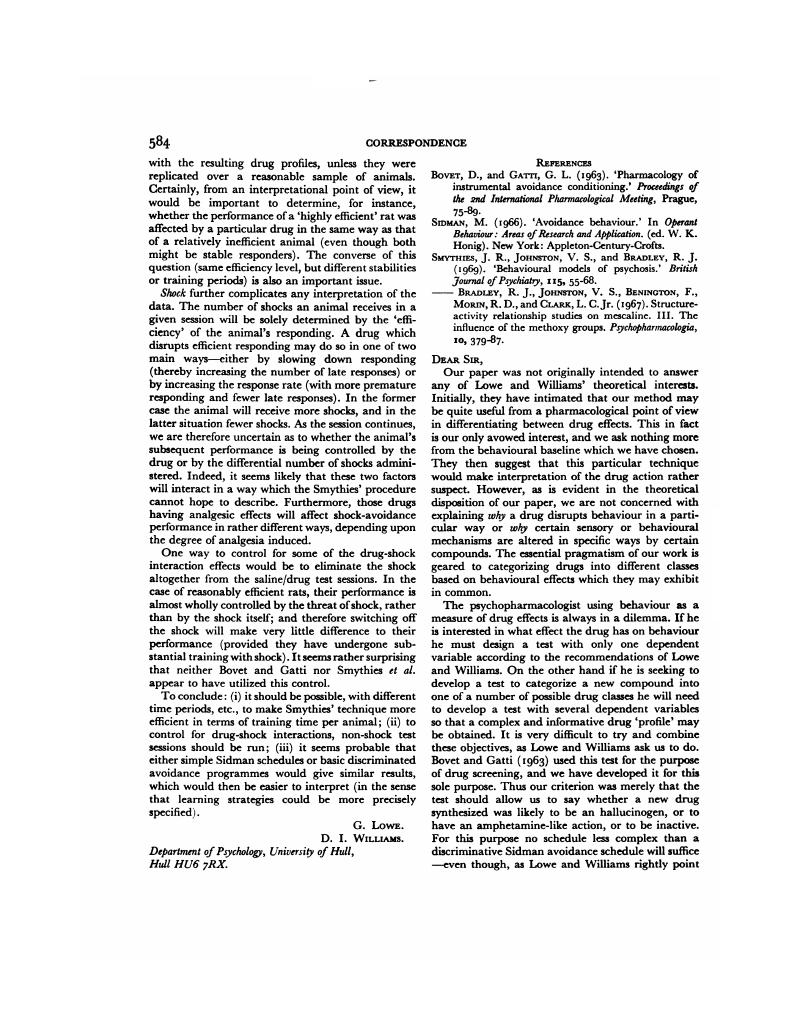No CrossRef data available.
Article contents
Smythies' use of the 'Sidman Schedule’ As an Animal Test for Hallucinogenic Drug Effects
Published online by Cambridge University Press: 29 January 2018
Abstract
An abstract is not available for this content so a preview has been provided. As you have access to this content, a full PDF is available via the ‘Save PDF’ action button.

- Type
- Correspondence
- Information
- Copyright
- Copyright © Royal College of Psychiatrists, 1971
References
Beaton, J. M., Smythies, J. R., Benington, F., and Morin, R. D. (1969). ‘The behavioural effects of 2,5-dimethoxy-4-methyl-amphetamine (DOM) in rats.’
Comm. Behav. Biol., 3(A), 81–84.Google Scholar
Beaton, J. M., LeBlanc, A. E., and Webster, C. D.
‘Bovet-Gatti profiles: a comparative study.’
In press.Google Scholar
Boren, J. J. (1966). ‘The study of drugs with operant techniques.’ In: Operant Behavior: Areas of Research and Application. (Ed. Honig, W. K.). New York: Appleton-Century-Crofts.Google Scholar
Bovet, D., and Gatti, G. L. (1963). ‘Pharmacology of instrumental avoidance conditioning.’
Proc. 2nd Int. Pharm. Meeting, Prague, 75–89.Google Scholar
Shulgin, A. T. (1970). ‘The mode of action of psychotomimetic drugs.’
NRP Bulletin, 8. (Ed. Smythies, J. R.)Google Scholar
Sidman, M. (1955). ‘Some properties of the warning stimulus in avoidance behavior.’
J. camp. Physiol. Psychol., 48, 444–50.CrossRefGoogle ScholarPubMed
Smythies, J. R., Bradley, R. J., Johnston, V. S., Benington, F., Morin, R. D., and Clark, L. C. (1967). ‘Structure-Activity relationship studies on mescaline III. The influence of the methoxy group.’
Psychopharmacologia, 10, 379–87.CrossRefGoogle Scholar
Smythies, J. R., Johnston, V. S., Bradley, R. J., Benington, F., Morin, R. D., and Clark, L. C. (1967b). ‘Some new behaviour-disrupting amphetamines and their significance.’
Nature, 216, 128–9.CrossRefGoogle ScholarPubMed
Smythies, J. R., Johnston, V. S., and Bradley, R. J., (1968). ‘The mechanism of action of hallucinogens.’
Comm. Behav. Biol., 1(A), 213–20.Google Scholar
Smythies, J. R., Johnston, V. S., and Bradley, R. J. (1969). ‘Behavioural models of psychosis.’
British Journal of Psychiatry, 115, 55–68.CrossRefGoogle ScholarPubMed
Snyder, S. H., Faillace, L., and Hollister, L. (1967). ‘2,5-Dimethoxy-4-methyl-amphetamine (STP): a new hallucinogenic drug.’
Science, 158, 669–700.Google Scholar
Takaori, S., Yada, N., and Mori, G. (1969). ‘Effects of psychotropic agents on Sidman avoidance response in good- and poor-performed rats.’
Japanese Journal of Pharmacology, 19, 587–96.Google Scholar



eLetters
No eLetters have been published for this article.